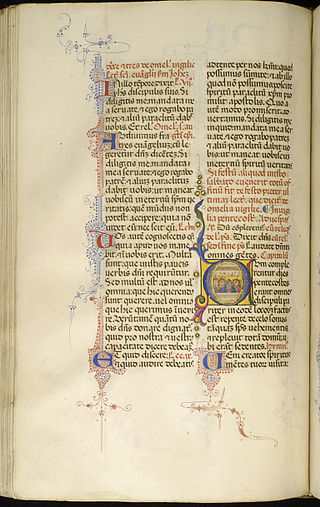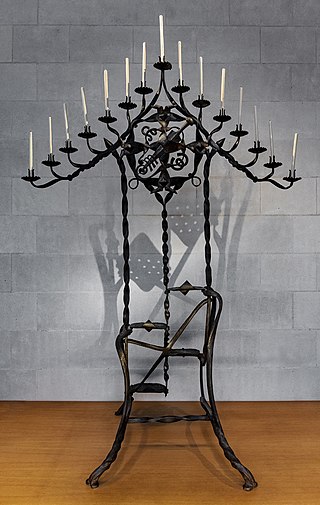Related Research Articles

The Roman Breviary is a breviary of the Roman Rite in the Catholic Church. A liturgical book, it contains public or canonical prayers, hymns, the Psalms, readings, and notations for everyday use, especially by bishops, priests, and deacons in the Divine Office.

The calendar of saints is the traditional Christian method of organizing a liturgical year by associating each day with one or more saints and referring to the day as the feast day or feast of said saint. The word "feast" in this context does not mean "a large meal, typically a celebratory one", but instead "an annual religious celebration, a day dedicated to a particular saint".

Vespers is a liturgy of evening prayer, one of the canonical hours in Catholic, Eastern Orthodox, Oriental Orthodox, and Lutheran liturgies. The word for this prayer time comes from the Latin vesper, meaning "evening".

In the practice of Christianity, canonical hours mark the divisions of the day in terms of fixed times of prayer at regular intervals. A book of hours, chiefly a breviary, normally contains a version of, or selection from, such prayers.

Matins is a canonical hour in Christian liturgy, originally sung during the darkness of early morning.

Tenebrae is a religious service of Western Christianity held during the three days preceding Easter Day, and characterized by gradual extinguishing of candles, and by a "strepitus" or "loud noise" taking place in total darkness near the end of the service.

The Liturgy of the Hours, Divine Office, or Opus Dei are a set of Catholic prayers comprising the canonical hours, often also referred to as the breviary, of the Latin Church. The Liturgy of the Hours forms the official set of prayers "marking the hours of each day and sanctifying the day with prayer." The term "Liturgy of the Hours" has been retroactively applied to the practices of saying the canonical hours in both the Christian East and West–particularly within the Latin liturgical rites–prior to the Second Vatican Council, and is the official term for the canonical hours promulgated for usage by the Latin Church in 1971. Before 1971, the official form for the Latin Church was the Breviarium Romanum, first published in 1568 with major editions through 1962.

The Office of the Dead or Office for the Dead is a prayer cycle of the Canonical Hours in the Catholic Church, Anglican Church and Lutheran Church, said for the repose of the soul of a decedent. It is the proper reading on All Souls' Day for all departed souls (Purgatory), and can be a votive office on other days when said for a particular decedent. The work is composed of different psalms, scripture, prayers and other parts, divided into The Office of Readings, Lauds, Daytime Prayer, Vespers and Compline.
In the Latin liturgical rites of the Catholic Church, a commemoration is the recital, within the Liturgy of the Hours or the Mass of one celebration, of part of another celebration that is generally of lower rank and impeded because of a coincidence of date.

An antiphonary or antiphonal is one of the liturgical books intended for use in choro, and originally characterized, as its name implies, by the assignment to it principally of the antiphons used in various parts of the Latin liturgical rites.
The Use of York or York Rite was a liturgical use of the Roman Rite – itself a Latin liturgical rite – practised in part of northern England, prior to the reign of Henry VIII. During Henry's reign the Use of York was suppressed in favour of the Use of Sarum, developed at Salisbury Cathedral, followed by the Book of Common Prayer. "Use" denotes the special liturgical customs which prevailed in a particular diocese or group of dioceses; it is one of the medieval English uses, together with the Use of Sarum, the Use of Hereford, and the Use of Bangor.

The Dominican Rite is the unique liturgical rite of the Dominican Order in the Catholic Church. It has been classified differently by different sources – some consider it a usage of the Roman Rite, others a variant of the Gallican Rite, and still others a form of the Roman Rite into which Gallican elements were inserted.
The Tridentine calendar is the calendar of saints to be honoured in the course of the liturgical year in the official liturgy of the Roman Rite as reformed by Pope Pius V, implementing a decision of the Council of Trent, which entrusted the task to the Pope.

Agapitus is venerated as a martyr saint, who died on August 18, perhaps in 274, a date that the latest editions of the Roman Martyrology say is uncertain.

The Ambrosian Rite is a Latin Catholic liturgical Western Rite used in the area of Milan. The Traditional Ambrosian Rite is the form of this rite as it was used before the changes that followed the Second Vatican Council.

A liturgical book, or service book, is a book published by the authority of a church body that contains the text and directions for the liturgy of its official religious services.
The Code of Rubrics is a three-part liturgical document promulgated in 1960 under Pope John XXIII, which in the form of a legal code indicated the liturgical and sacramental law governing the celebration of the Roman Rite Mass and Divine Office.

Conditor alme siderum is a seventh-century Latin hymn used during the Christian liturgical season of Advent. It is also known in English as Creator of the Stars of Night, from a translation by J.M. Neale.
George Herbert Palmer was an English Anglo-Catholic priest, musicologist, organist, and expert on plainchant, particularly of the Sarum Use. Named after the priest and poet George Herbert, he was ordained a priest in Chester in 1871 and later was organist of St Margaret's Church in Toxteth Park, Liverpool, and St Barnabas, Pimlico, London. He helped found the Plainsong and Medieval Music Society (PMMS) in 1888. The majority of his extensive editions of liturgical music and texts were produced by the PMMS and the Community of St Mary the Virgin at Wantage in Oxfordshire. He was notable and influential for his musically sensitive translations of Latin hymns into English.
The Cistercian Hymnal is a compilation of the ancient texts and melodies sung by Cistercian monks and nuns during the Liturgy of the Hours. This collection of hymns influenced the Cistercian Order's identity, since early abbots emphasized the compositions' musical quality. The hymnal developed in the course of the centuries.
References
- ↑ "ISTE CONFESSOR DOMINI COLENTES". Encyclopedia.Com. Retrieved 23 Oct 2018.
- ↑ Connelly, Joseph. "Hymns of the Roman Liturgy" (PDF). Corpus Christi Watershed. 1954. Retrieved 25 October 2018.
- ↑ "Iste confessor Domini Colentes". Hymnary.Org. Retrieved 23 Oct 2018.
- ↑ Britt OSB, Rev Matthew. "The Hymns of the Breviary and Missal" (PDF). Musica Sacra. Benziger Brothers. Retrieved 25 October 2018.
- ↑ Dipippo, Gregory. "The Feast of St Martin". New Liturgical Movement. Retrieved 23 October 2018.
- ↑ "Iste Confessor". St Augustine's Lyre. 17 April 2017. Retrieved 23 October 2018.
- ↑ Liturgia horarum: iuxta ritum romanum (Editio typica altera ed.). Città del Vaticano: Libreria editrice vaticana. p. 1351. ISBN 88-209-2809-4.
- ↑ Breviarium Romanum Romae Typis Vaticanis. 1632. p. xlvi. Retrieved 16 April 2020.
- ↑ "La nueva simplificacion de las rubricas" (PDF). p. 145. Retrieved 16 April 2020.
- ↑ "Iste Confessor". St Augustine's Lyre. 17 April 2017. Retrieved 23 October 2018.
 This article incorporates text from this source, which is in the public domain .
This article incorporates text from this source, which is in the public domain . - ↑ "Iste Confessor". Cantus Index. Retrieved 23 October 2018.
 This article incorporates text from this source, which is in the public domain .
This article incorporates text from this source, which is in the public domain . - ↑ "This is the day". Breviary Hymns. 25 September 2013. Retrieved 24 October 2018.
 This article incorporates text from this source, which is in the public domain .
This article incorporates text from this source, which is in the public domain . - ↑ "The Confessor of Christ from shore to shore". St Augustine's Lyre. 17 April 2017. Retrieved 24 October 2018.
 This article incorporates text from this source, which is in the public domain .
This article incorporates text from this source, which is in the public domain . - ↑ "He Whose confession God of old accepted". Hymn Time. Archived from the original on 25 October 2018. Retrieved 24 October 2018.
 This article incorporates text from this source, which is in the public domain .
This article incorporates text from this source, which is in the public domain .